Accounting Business: Analyzing Enterprise Forms, Shares and Long Debts
VerifiedAdded on 2023/06/18
|7
|1467
|301
Report
AI Summary
This report provides an overview of key accounting business concepts, focusing on different forms of business enterprises, including sole proprietorships, partnerships, and companies, highlighting their distinct liabilities, tax benefits, and operational structures. It further examines the differences between equity share capital and preference share capital, detailing dividend payout priorities, capital repayment during liquidation, and associated risks. Additionally, the report contrasts debentures and bonds as long-term debt instruments, considering collateral requirements, interest rates, convertibility, and risk levels. The report concludes by summarizing the importance of understanding these financial structures and instruments in the context of business accounting.
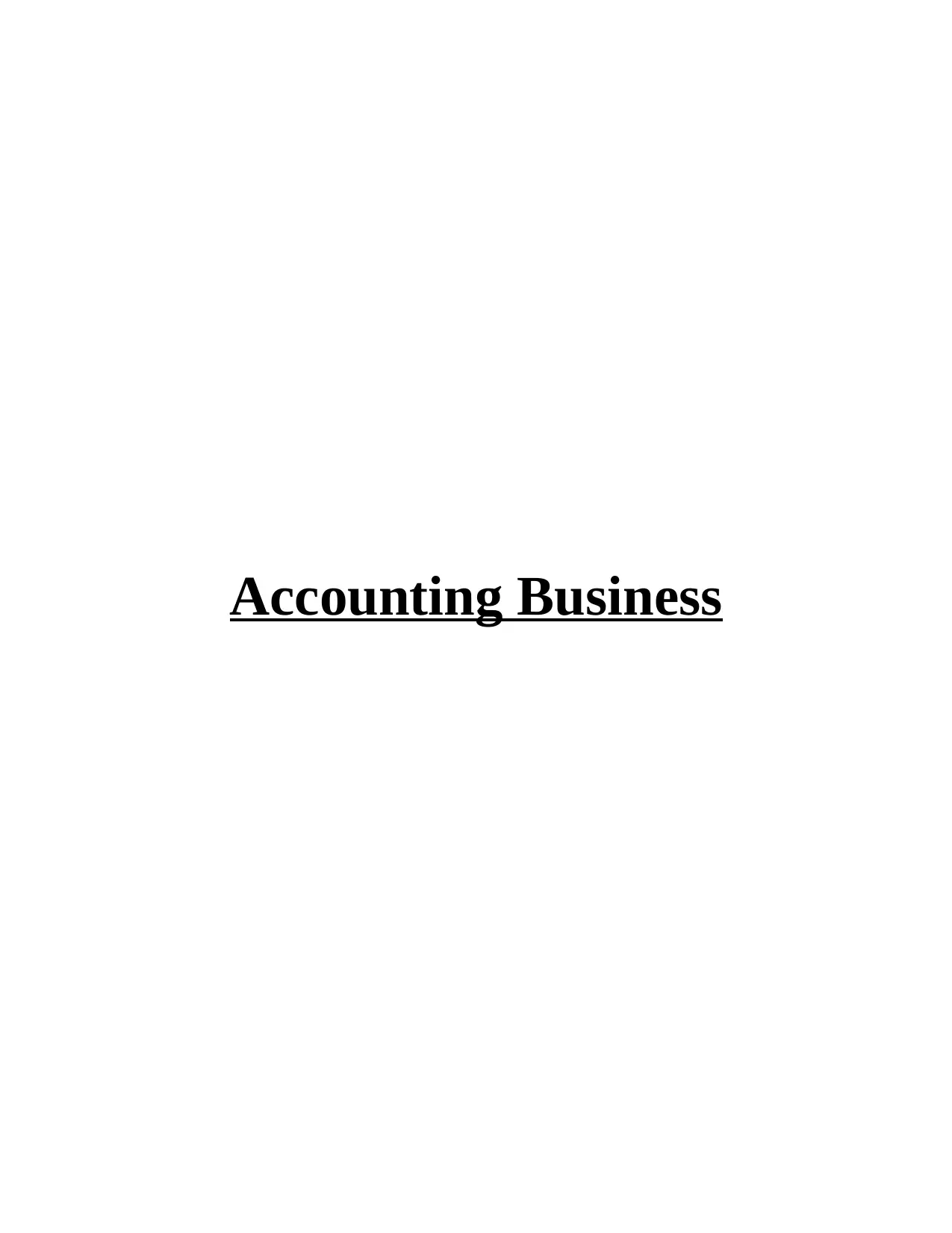
Accounting Business
Paraphrase This Document
Need a fresh take? Get an instant paraphrase of this document with our AI Paraphraser
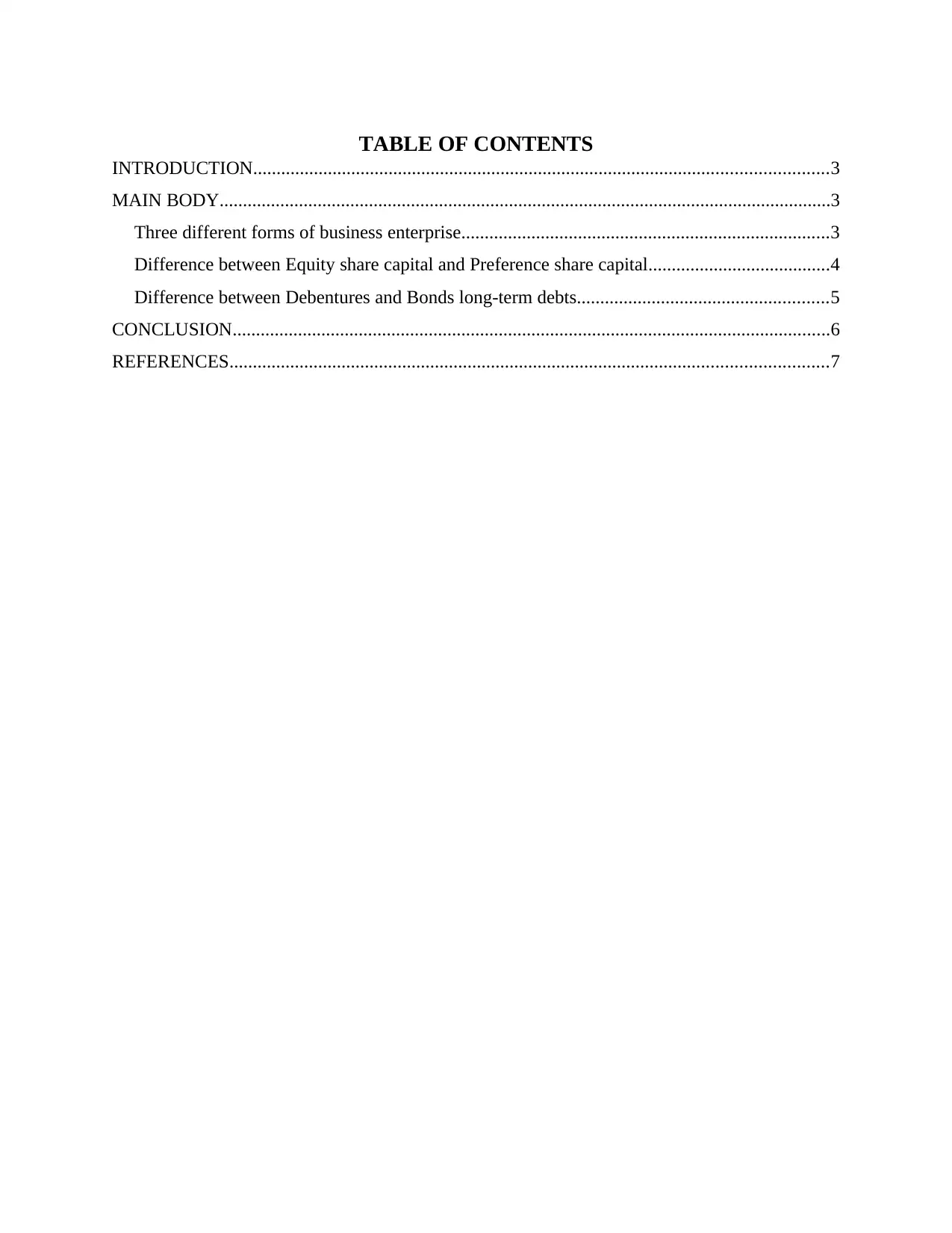
TABLE OF CONTENTS
INTRODUCTION...........................................................................................................................3
MAIN BODY...................................................................................................................................3
Three different forms of business enterprise...............................................................................3
Difference between Equity share capital and Preference share capital.......................................4
Difference between Debentures and Bonds long-term debts......................................................5
CONCLUSION................................................................................................................................6
REFERENCES................................................................................................................................7
INTRODUCTION...........................................................................................................................3
MAIN BODY...................................................................................................................................3
Three different forms of business enterprise...............................................................................3
Difference between Equity share capital and Preference share capital.......................................4
Difference between Debentures and Bonds long-term debts......................................................5
CONCLUSION................................................................................................................................6
REFERENCES................................................................................................................................7
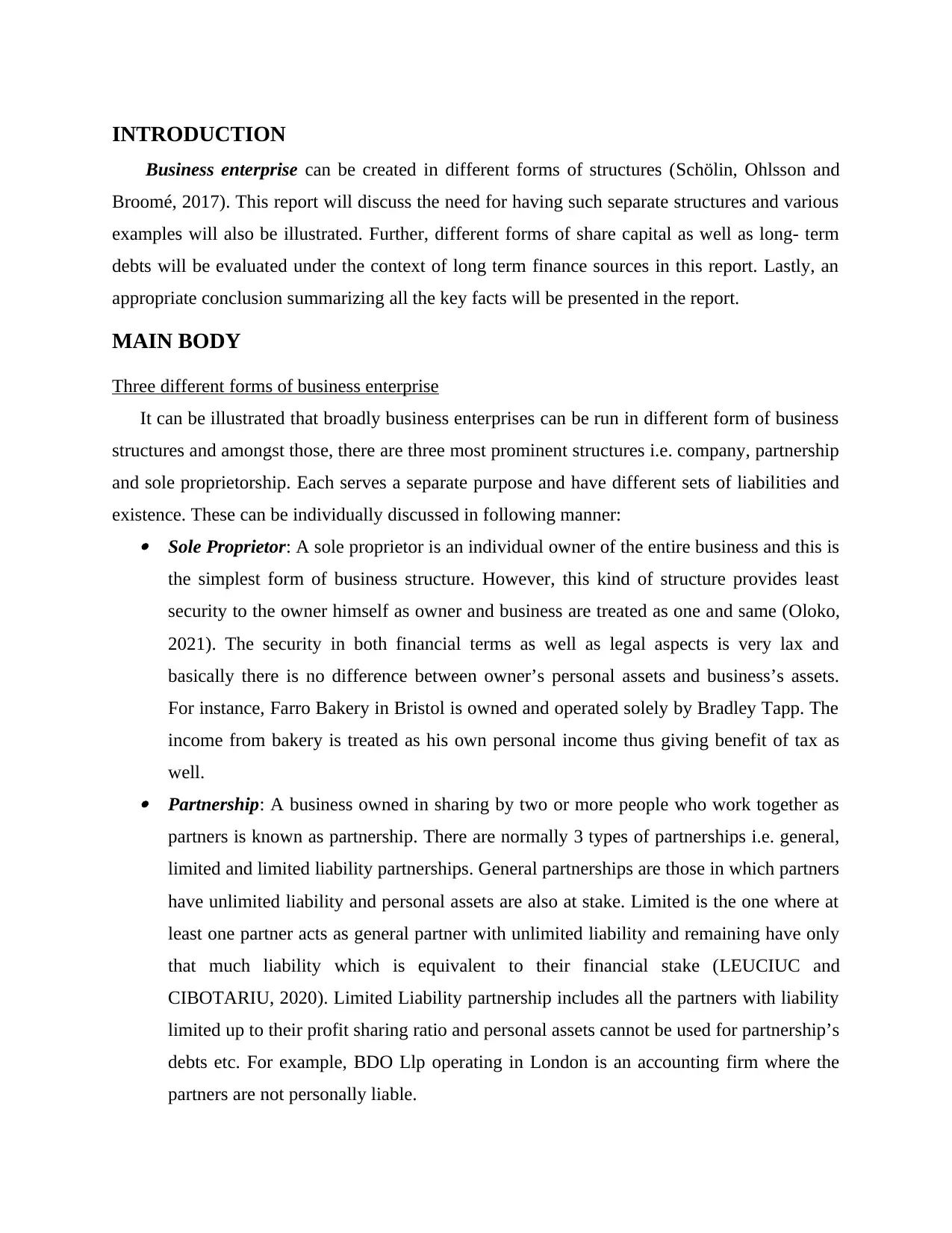
INTRODUCTION
Business enterprise can be created in different forms of structures (Schölin, Ohlsson and
Broomé, 2017). This report will discuss the need for having such separate structures and various
examples will also be illustrated. Further, different forms of share capital as well as long- term
debts will be evaluated under the context of long term finance sources in this report. Lastly, an
appropriate conclusion summarizing all the key facts will be presented in the report.
MAIN BODY
Three different forms of business enterprise
It can be illustrated that broadly business enterprises can be run in different form of business
structures and amongst those, there are three most prominent structures i.e. company, partnership
and sole proprietorship. Each serves a separate purpose and have different sets of liabilities and
existence. These can be individually discussed in following manner: Sole Proprietor: A sole proprietor is an individual owner of the entire business and this is
the simplest form of business structure. However, this kind of structure provides least
security to the owner himself as owner and business are treated as one and same (Oloko,
2021). The security in both financial terms as well as legal aspects is very lax and
basically there is no difference between owner’s personal assets and business’s assets.
For instance, Farro Bakery in Bristol is owned and operated solely by Bradley Tapp. The
income from bakery is treated as his own personal income thus giving benefit of tax as
well. Partnership: A business owned in sharing by two or more people who work together as
partners is known as partnership. There are normally 3 types of partnerships i.e. general,
limited and limited liability partnerships. General partnerships are those in which partners
have unlimited liability and personal assets are also at stake. Limited is the one where at
least one partner acts as general partner with unlimited liability and remaining have only
that much liability which is equivalent to their financial stake (LEUCIUC and
CIBOTARIU, 2020). Limited Liability partnership includes all the partners with liability
limited up to their profit sharing ratio and personal assets cannot be used for partnership’s
debts etc. For example, BDO Llp operating in London is an accounting firm where the
partners are not personally liable.
Business enterprise can be created in different forms of structures (Schölin, Ohlsson and
Broomé, 2017). This report will discuss the need for having such separate structures and various
examples will also be illustrated. Further, different forms of share capital as well as long- term
debts will be evaluated under the context of long term finance sources in this report. Lastly, an
appropriate conclusion summarizing all the key facts will be presented in the report.
MAIN BODY
Three different forms of business enterprise
It can be illustrated that broadly business enterprises can be run in different form of business
structures and amongst those, there are three most prominent structures i.e. company, partnership
and sole proprietorship. Each serves a separate purpose and have different sets of liabilities and
existence. These can be individually discussed in following manner: Sole Proprietor: A sole proprietor is an individual owner of the entire business and this is
the simplest form of business structure. However, this kind of structure provides least
security to the owner himself as owner and business are treated as one and same (Oloko,
2021). The security in both financial terms as well as legal aspects is very lax and
basically there is no difference between owner’s personal assets and business’s assets.
For instance, Farro Bakery in Bristol is owned and operated solely by Bradley Tapp. The
income from bakery is treated as his own personal income thus giving benefit of tax as
well. Partnership: A business owned in sharing by two or more people who work together as
partners is known as partnership. There are normally 3 types of partnerships i.e. general,
limited and limited liability partnerships. General partnerships are those in which partners
have unlimited liability and personal assets are also at stake. Limited is the one where at
least one partner acts as general partner with unlimited liability and remaining have only
that much liability which is equivalent to their financial stake (LEUCIUC and
CIBOTARIU, 2020). Limited Liability partnership includes all the partners with liability
limited up to their profit sharing ratio and personal assets cannot be used for partnership’s
debts etc. For example, BDO Llp operating in London is an accounting firm where the
partners are not personally liable.
⊘ This is a preview!⊘
Do you want full access?
Subscribe today to unlock all pages.

Trusted by 1+ million students worldwide
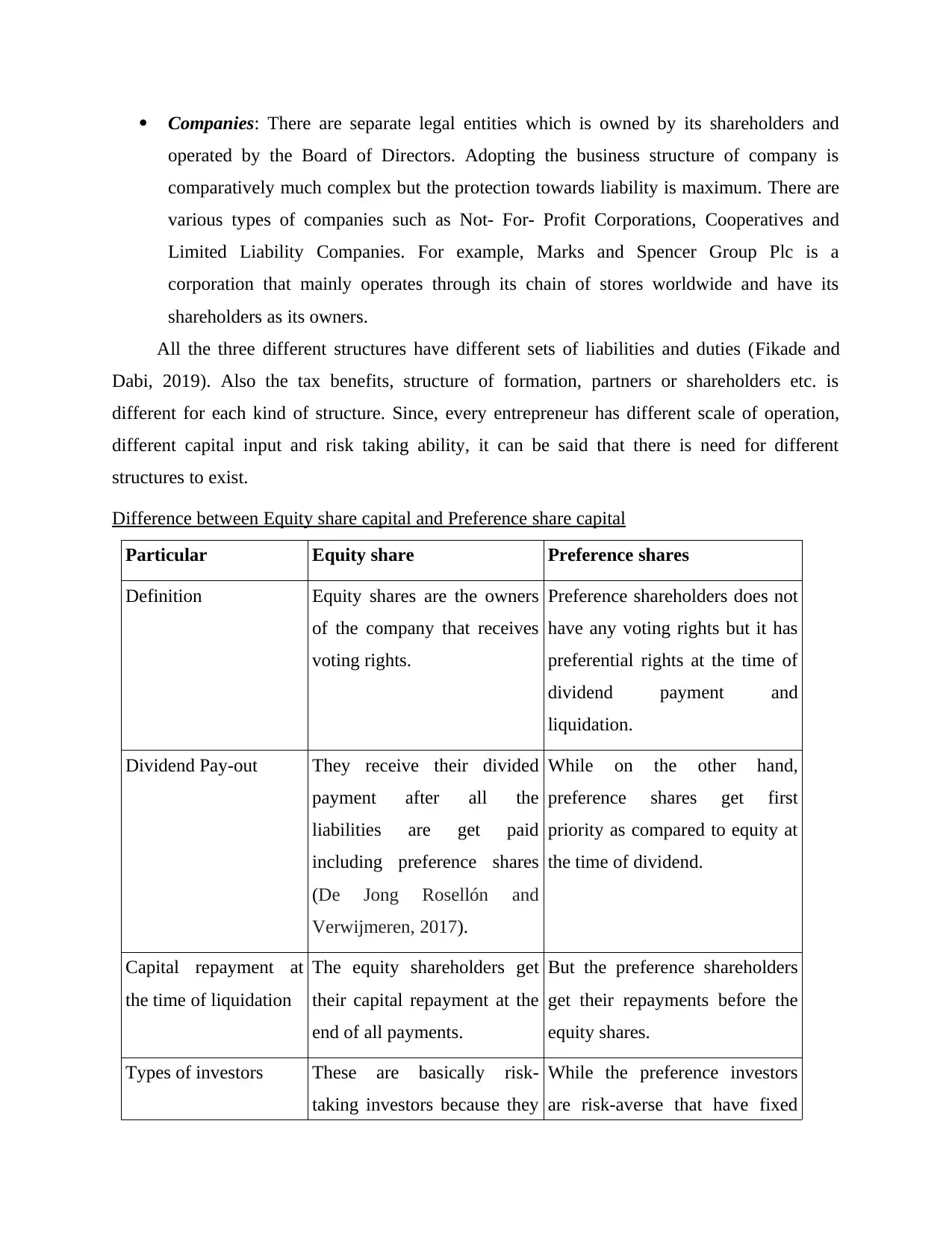
Companies: There are separate legal entities which is owned by its shareholders and
operated by the Board of Directors. Adopting the business structure of company is
comparatively much complex but the protection towards liability is maximum. There are
various types of companies such as Not- For- Profit Corporations, Cooperatives and
Limited Liability Companies. For example, Marks and Spencer Group Plc is a
corporation that mainly operates through its chain of stores worldwide and have its
shareholders as its owners.
All the three different structures have different sets of liabilities and duties (Fikade and
Dabi, 2019). Also the tax benefits, structure of formation, partners or shareholders etc. is
different for each kind of structure. Since, every entrepreneur has different scale of operation,
different capital input and risk taking ability, it can be said that there is need for different
structures to exist.
Difference between Equity share capital and Preference share capital
Particular Equity share Preference shares
Definition Equity shares are the owners
of the company that receives
voting rights.
Preference shareholders does not
have any voting rights but it has
preferential rights at the time of
dividend payment and
liquidation.
Dividend Pay-out They receive their divided
payment after all the
liabilities are get paid
including preference shares
(De Jong Rosellón and
Verwijmeren, 2017).
While on the other hand,
preference shares get first
priority as compared to equity at
the time of dividend.
Capital repayment at
the time of liquidation
The equity shareholders get
their capital repayment at the
end of all payments.
But the preference shareholders
get their repayments before the
equity shares.
Types of investors These are basically risk-
taking investors because they
While the preference investors
are risk-averse that have fixed
operated by the Board of Directors. Adopting the business structure of company is
comparatively much complex but the protection towards liability is maximum. There are
various types of companies such as Not- For- Profit Corporations, Cooperatives and
Limited Liability Companies. For example, Marks and Spencer Group Plc is a
corporation that mainly operates through its chain of stores worldwide and have its
shareholders as its owners.
All the three different structures have different sets of liabilities and duties (Fikade and
Dabi, 2019). Also the tax benefits, structure of formation, partners or shareholders etc. is
different for each kind of structure. Since, every entrepreneur has different scale of operation,
different capital input and risk taking ability, it can be said that there is need for different
structures to exist.
Difference between Equity share capital and Preference share capital
Particular Equity share Preference shares
Definition Equity shares are the owners
of the company that receives
voting rights.
Preference shareholders does not
have any voting rights but it has
preferential rights at the time of
dividend payment and
liquidation.
Dividend Pay-out They receive their divided
payment after all the
liabilities are get paid
including preference shares
(De Jong Rosellón and
Verwijmeren, 2017).
While on the other hand,
preference shares get first
priority as compared to equity at
the time of dividend.
Capital repayment at
the time of liquidation
The equity shareholders get
their capital repayment at the
end of all payments.
But the preference shareholders
get their repayments before the
equity shares.
Types of investors These are basically risk-
taking investors because they
While the preference investors
are risk-averse that have fixed
Paraphrase This Document
Need a fresh take? Get an instant paraphrase of this document with our AI Paraphraser
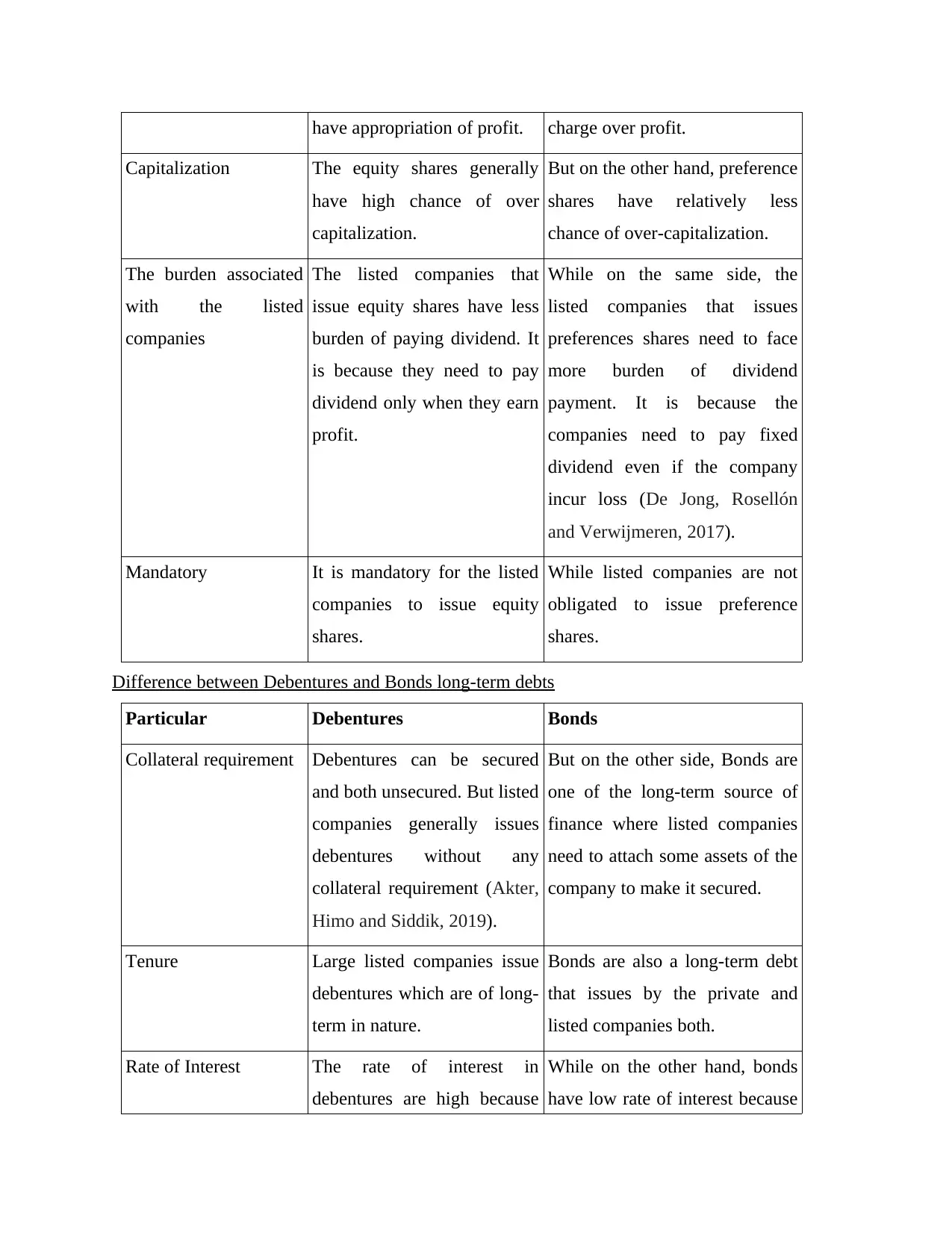
have appropriation of profit. charge over profit.
Capitalization The equity shares generally
have high chance of over
capitalization.
But on the other hand, preference
shares have relatively less
chance of over-capitalization.
The burden associated
with the listed
companies
The listed companies that
issue equity shares have less
burden of paying dividend. It
is because they need to pay
dividend only when they earn
profit.
While on the same side, the
listed companies that issues
preferences shares need to face
more burden of dividend
payment. It is because the
companies need to pay fixed
dividend even if the company
incur loss (De Jong, Rosellón
and Verwijmeren, 2017).
Mandatory It is mandatory for the listed
companies to issue equity
shares.
While listed companies are not
obligated to issue preference
shares.
Difference between Debentures and Bonds long-term debts
Particular Debentures Bonds
Collateral requirement Debentures can be secured
and both unsecured. But listed
companies generally issues
debentures without any
collateral requirement (Akter,
Himo and Siddik, 2019).
But on the other side, Bonds are
one of the long-term source of
finance where listed companies
need to attach some assets of the
company to make it secured.
Tenure Large listed companies issue
debentures which are of long-
term in nature.
Bonds are also a long-term debt
that issues by the private and
listed companies both.
Rate of Interest The rate of interest in
debentures are high because
While on the other hand, bonds
have low rate of interest because
Capitalization The equity shares generally
have high chance of over
capitalization.
But on the other hand, preference
shares have relatively less
chance of over-capitalization.
The burden associated
with the listed
companies
The listed companies that
issue equity shares have less
burden of paying dividend. It
is because they need to pay
dividend only when they earn
profit.
While on the same side, the
listed companies that issues
preferences shares need to face
more burden of dividend
payment. It is because the
companies need to pay fixed
dividend even if the company
incur loss (De Jong, Rosellón
and Verwijmeren, 2017).
Mandatory It is mandatory for the listed
companies to issue equity
shares.
While listed companies are not
obligated to issue preference
shares.
Difference between Debentures and Bonds long-term debts
Particular Debentures Bonds
Collateral requirement Debentures can be secured
and both unsecured. But listed
companies generally issues
debentures without any
collateral requirement (Akter,
Himo and Siddik, 2019).
But on the other side, Bonds are
one of the long-term source of
finance where listed companies
need to attach some assets of the
company to make it secured.
Tenure Large listed companies issue
debentures which are of long-
term in nature.
Bonds are also a long-term debt
that issues by the private and
listed companies both.
Rate of Interest The rate of interest in
debentures are high because
While on the other hand, bonds
have low rate of interest because
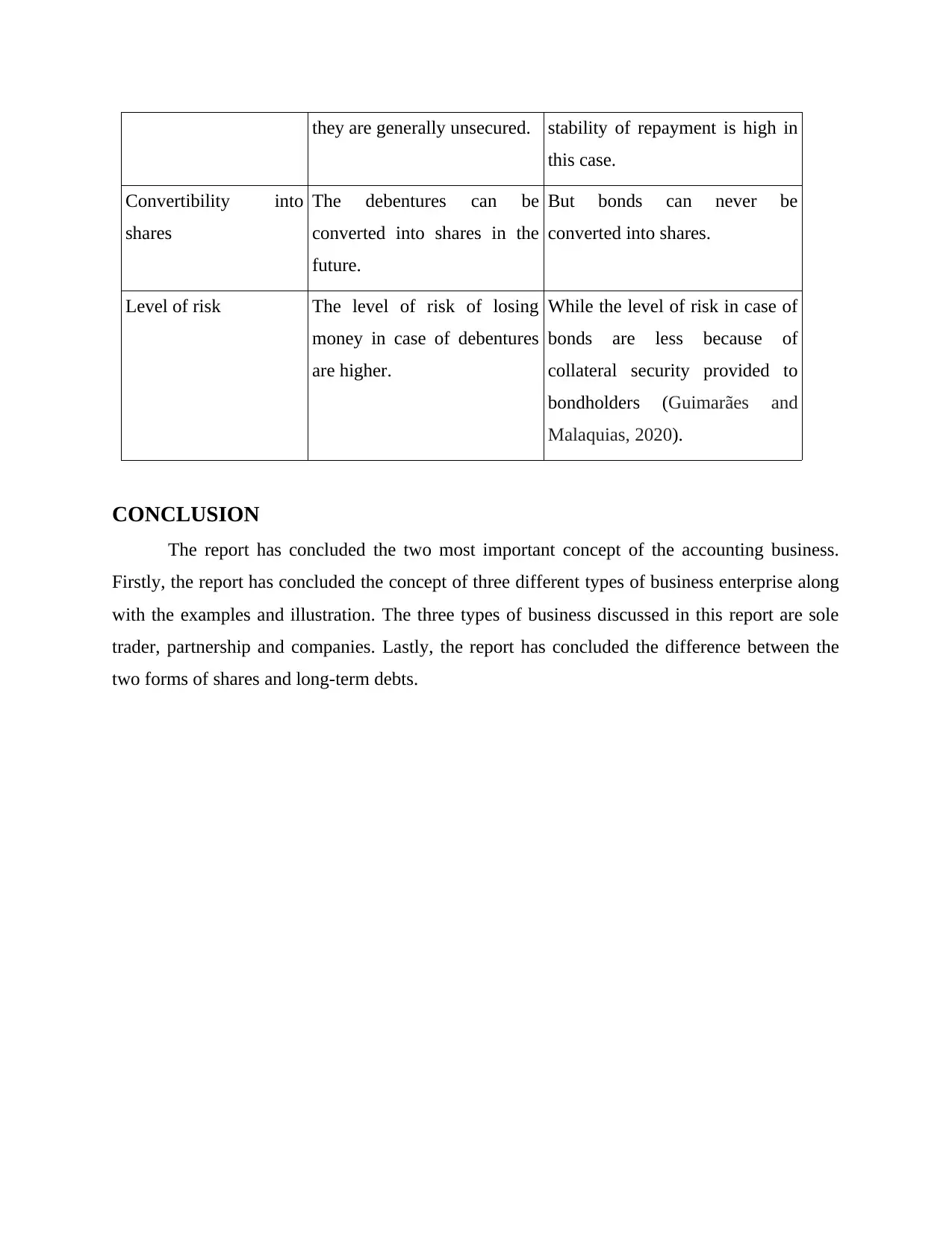
they are generally unsecured. stability of repayment is high in
this case.
Convertibility into
shares
The debentures can be
converted into shares in the
future.
But bonds can never be
converted into shares.
Level of risk The level of risk of losing
money in case of debentures
are higher.
While the level of risk in case of
bonds are less because of
collateral security provided to
bondholders (Guimarães and
Malaquias, 2020).
CONCLUSION
The report has concluded the two most important concept of the accounting business.
Firstly, the report has concluded the concept of three different types of business enterprise along
with the examples and illustration. The three types of business discussed in this report are sole
trader, partnership and companies. Lastly, the report has concluded the difference between the
two forms of shares and long-term debts.
this case.
Convertibility into
shares
The debentures can be
converted into shares in the
future.
But bonds can never be
converted into shares.
Level of risk The level of risk of losing
money in case of debentures
are higher.
While the level of risk in case of
bonds are less because of
collateral security provided to
bondholders (Guimarães and
Malaquias, 2020).
CONCLUSION
The report has concluded the two most important concept of the accounting business.
Firstly, the report has concluded the concept of three different types of business enterprise along
with the examples and illustration. The three types of business discussed in this report are sole
trader, partnership and companies. Lastly, the report has concluded the difference between the
two forms of shares and long-term debts.
⊘ This is a preview!⊘
Do you want full access?
Subscribe today to unlock all pages.

Trusted by 1+ million students worldwide
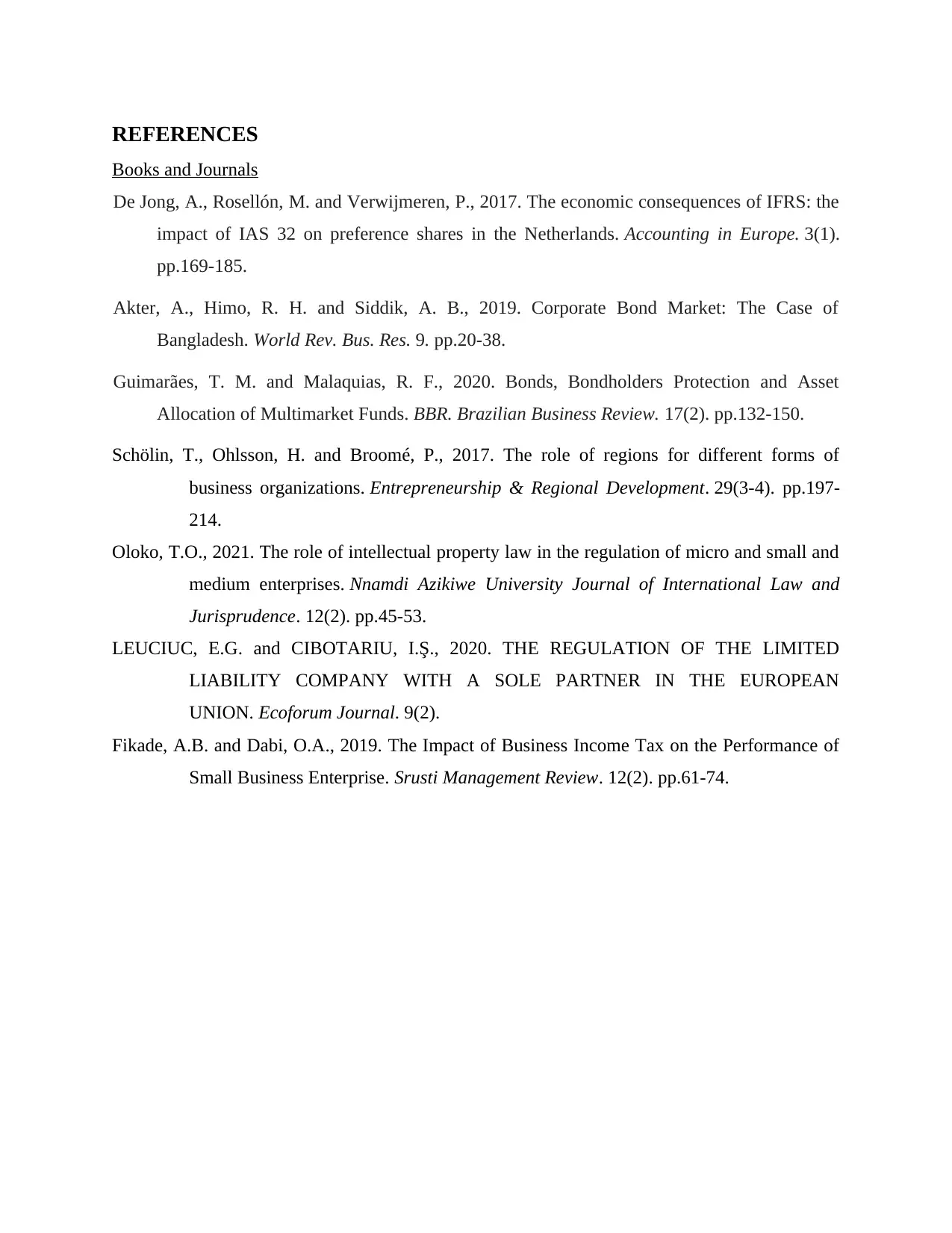
REFERENCES
Books and Journals
De Jong, A., Rosellón, M. and Verwijmeren, P., 2017. The economic consequences of IFRS: the
impact of IAS 32 on preference shares in the Netherlands. Accounting in Europe. 3(1).
pp.169-185.
Akter, A., Himo, R. H. and Siddik, A. B., 2019. Corporate Bond Market: The Case of
Bangladesh. World Rev. Bus. Res. 9. pp.20-38.
Guimarães, T. M. and Malaquias, R. F., 2020. Bonds, Bondholders Protection and Asset
Allocation of Multimarket Funds. BBR. Brazilian Business Review. 17(2). pp.132-150.
Schölin, T., Ohlsson, H. and Broomé, P., 2017. The role of regions for different forms of
business organizations. Entrepreneurship & Regional Development. 29(3-4). pp.197-
214.
Oloko, T.O., 2021. The role of intellectual property law in the regulation of micro and small and
medium enterprises. Nnamdi Azikiwe University Journal of International Law and
Jurisprudence. 12(2). pp.45-53.
LEUCIUC, E.G. and CIBOTARIU, I.Ş., 2020. THE REGULATION OF THE LIMITED
LIABILITY COMPANY WITH A SOLE PARTNER IN THE EUROPEAN
UNION. Ecoforum Journal. 9(2).
Fikade, A.B. and Dabi, O.A., 2019. The Impact of Business Income Tax on the Performance of
Small Business Enterprise. Srusti Management Review. 12(2). pp.61-74.
Books and Journals
De Jong, A., Rosellón, M. and Verwijmeren, P., 2017. The economic consequences of IFRS: the
impact of IAS 32 on preference shares in the Netherlands. Accounting in Europe. 3(1).
pp.169-185.
Akter, A., Himo, R. H. and Siddik, A. B., 2019. Corporate Bond Market: The Case of
Bangladesh. World Rev. Bus. Res. 9. pp.20-38.
Guimarães, T. M. and Malaquias, R. F., 2020. Bonds, Bondholders Protection and Asset
Allocation of Multimarket Funds. BBR. Brazilian Business Review. 17(2). pp.132-150.
Schölin, T., Ohlsson, H. and Broomé, P., 2017. The role of regions for different forms of
business organizations. Entrepreneurship & Regional Development. 29(3-4). pp.197-
214.
Oloko, T.O., 2021. The role of intellectual property law in the regulation of micro and small and
medium enterprises. Nnamdi Azikiwe University Journal of International Law and
Jurisprudence. 12(2). pp.45-53.
LEUCIUC, E.G. and CIBOTARIU, I.Ş., 2020. THE REGULATION OF THE LIMITED
LIABILITY COMPANY WITH A SOLE PARTNER IN THE EUROPEAN
UNION. Ecoforum Journal. 9(2).
Fikade, A.B. and Dabi, O.A., 2019. The Impact of Business Income Tax on the Performance of
Small Business Enterprise. Srusti Management Review. 12(2). pp.61-74.
1 out of 7
Related Documents
Your All-in-One AI-Powered Toolkit for Academic Success.
+13062052269
info@desklib.com
Available 24*7 on WhatsApp / Email
![[object Object]](/_next/static/media/star-bottom.7253800d.svg)
Unlock your academic potential
Copyright © 2020–2025 A2Z Services. All Rights Reserved. Developed and managed by ZUCOL.





